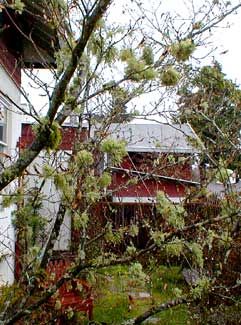
|
Lichens
"Lichen, mistletoe, aloft
(1893-1961) |
A vast number of epiphytic macrolichens are common throughout Pacific Northwest forests. That they are epiphytes means these live in trees obtaining nutrients from the atmosphere rather than from soil.
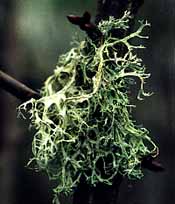 The first photo shows our Vine Maple in its winter appearance, leafless & boldly revealing its intense growth of fluffy lichens growing throughout the entirety of its limb structure. This is completely harmless to the tree. Indeed, the relationship is helpful to the Vine Maple, as the lichen protects it from harsh winter winds, & from moisture loss in a droughty summer. (You can view more portraits of the lichen-ornamented limbs on the Vine Maple page along the Winter Bark Garden Walk).
The first photo shows our Vine Maple in its winter appearance, leafless & boldly revealing its intense growth of fluffy lichens growing throughout the entirety of its limb structure. This is completely harmless to the tree. Indeed, the relationship is helpful to the Vine Maple, as the lichen protects it from harsh winter winds, & from moisture loss in a droughty summer. (You can view more portraits of the lichen-ornamented limbs on the Vine Maple page along the Winter Bark Garden Walk).Lichens are curious & highly successful composite organisms consisting of a fungus growing in symbiotic concert with an algae, so that lichens become the only fungal organism capable of photosynthesis thanks to this amazing union. The fungal partner in this relationship is called the mycobiont, & the algal partner is the photobiont. The exact species involved, & the forms taken by the composite plant organism, are exceedingly numerous.
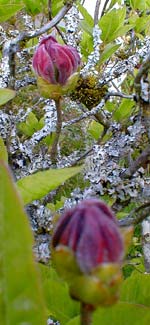 These twinned organisms also exist separate from these partnerships, but when a fungus is "lichenized" by symbiosis, the resulting plant no longer resembles either of the two organisms separately. The mycobiont forms the structure of the multiorganism to capture mineral elements from rainfall or water run-off, & the photobiont infused throughout the structure converts carbon dioxide into useable carbohydrates. Via these partnerships, the lichen is able to thrive in environments that neither organism could survive in separately.
These twinned organisms also exist separate from these partnerships, but when a fungus is "lichenized" by symbiosis, the resulting plant no longer resembles either of the two organisms separately. The mycobiont forms the structure of the multiorganism to capture mineral elements from rainfall or water run-off, & the photobiont infused throughout the structure converts carbon dioxide into useable carbohydrates. Via these partnerships, the lichen is able to thrive in environments that neither organism could survive in separately.This vastly oversimplifies a complex & diverse type of plant life, but I think my description effectively hints of lichens' interesting complexity. There are a great many kinds of lichens, & the second photo shows a stringier spongy form that barely resembles the vine maple's fluffier lichen. The stringier variety is growing in a cherry tree.
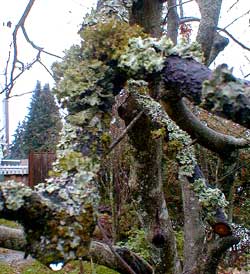 Lichens appear in the garden quite naturally with or without invitation, but for the type in the cherry tree, I intentionally introduced it after Granny Artemis & I went for a stroll through Bloedel Gardens during hurricane winds. We heard a mighty "crack!" as a huge Douglas fir came tumbling down that day. The gardens had to be cleared of visitors in a hurry, lest someone get killed. Lichens as well as branches were blowing down from the trees onto the path. Spongy lichens were scuttling in the wind; it looked like someone had blown up a mattress. I stuffed some wayward lichens in a pocket to introduce to a cherry tree at home, where it has taken hold & spread slowly.
Lichens appear in the garden quite naturally with or without invitation, but for the type in the cherry tree, I intentionally introduced it after Granny Artemis & I went for a stroll through Bloedel Gardens during hurricane winds. We heard a mighty "crack!" as a huge Douglas fir came tumbling down that day. The gardens had to be cleared of visitors in a hurry, lest someone get killed. Lichens as well as branches were blowing down from the trees onto the path. Spongy lichens were scuttling in the wind; it looked like someone had blown up a mattress. I stuffed some wayward lichens in a pocket to introduce to a cherry tree at home, where it has taken hold & spread slowly.The two types of lichens shown above form spongy balls which, as they grow larger, dangle from the limbs & crotches of forked branches, from which perches they capture impurities from the very atmosphere & from dripping rainwater, but never leach anything from the trees themselves, as lichens are in no way parasitic.
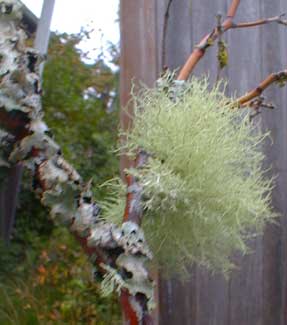 Another form that lichen commonly takes is of overlapping crusty mouse-ears & scallops that spread very close along branches & do not hang loose. The third photo shows the May buds of our "Western Flame" deciduous azalea (a hybrid of the Western Azalea & eastern Flame Azalea). You can see the "crusting" form of lichen on the limbs all around the buds. About 75 percent of this large shrub is textured with lichen. This sort of lichen is mixed with mosses in our chokecherry tree as well, as shown in the last two photos on this page; the very last photo shows a chokecherry limb with two kinds of lichen growing on it. There are some further portraits of lichen & limbs on the Chokecherry page along the Winter Bark Garden Walk.
Another form that lichen commonly takes is of overlapping crusty mouse-ears & scallops that spread very close along branches & do not hang loose. The third photo shows the May buds of our "Western Flame" deciduous azalea (a hybrid of the Western Azalea & eastern Flame Azalea). You can see the "crusting" form of lichen on the limbs all around the buds. About 75 percent of this large shrub is textured with lichen. This sort of lichen is mixed with mosses in our chokecherry tree as well, as shown in the last two photos on this page; the very last photo shows a chokecherry limb with two kinds of lichen growing on it. There are some further portraits of lichen & limbs on the Chokecherry page along the Winter Bark Garden Walk.Some gardeners worry when they see the crustier-looking types of lichens appear on trees or shrubs, & fret that it might be some kind of scaly disease or killer fungus. But, unlike witches' broom or mistletoe, there is absolutely nothing to worry about. Lichen never damages buds or leaves or flowers. It is completely safe & lends such a shrub a distinguished, weathered, aged beauty which is particularly striking in winter when leaves do not hide the lichens. So whenever lichens appear in the garden, they should be embraced as evidence of a healthy overall balance inviting to nature's processes.
In forests, these arboreal lichens are a food source for deer, bighorn sheep & so on, & provide nesting material for birds, & a habitat & food for butterfly larvae, beetles, spiders & so forth. For some animals, notably the flying squirrel, lichens provide the greater majority of winter repasts; the squirrels are in turn a primary winter prey for the spotted owl. So it's easy to see that lichens are a key component of environmental balance in the food chain. Lichens furthermore contribute to the amount of nitrogen in the ecosystem, as they can fix airborne or rain-fallen nitrogen. They also hold moisture in the forest canopy during dry spells.
Lichens do not grow only in trees, of course. They grow on stark tundras in even the harshest of regions, such as above the Arctic circle where elk or reindeer scrape through ice to reach lichens as their primary forage. They grow on high mountains, encrusting boulders, foraged by bighorn sheep. Throughout the world they have adapted to conditions that support few if any other plants at all. Some of them are so extremely slow in their growth that a small patch on an alpine boulder could be hundreds of years old, while others, especially those in the forest canopy, are rapid in their growth.